by Kim Sung-soo
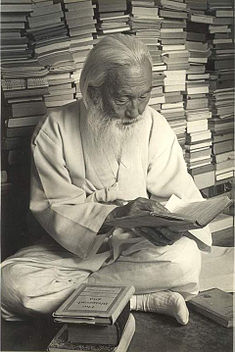
Portrait of Ham Sok-hon courtesy en.wikipedia.org
Ham Sok-hon (1901-1989) was known as the “Gandhi of Korea.” He sought to affirm the identity of Koreans at a time when Korea had fallen prey to Japanese imperialism. Ham believed that discovering one’s identity, especially as a colonized nation, was extremely important as it also determined one’s destiny. Without knowing who you are, it is very difficult to know what to do.
Ham was a civil rights activist when his country was ruled by dictatorial regimes (in both the North and South). Yet, as a maverick thinker, he tried his best to merge diverse religions and ideologies. Although he passed away nearly three decades ago, his legacy still inspires a considerable number of civil rights activists and liberal thinkers in Korea today.
Ham was born in North Korea and died in South Korea. He grew up on a small island in the Yellow Sea at the beginning of the 20th century. His father was a gentle and quiet herbal doctor, while his uncle was a man of action with vigorous Christian faith and a strong sense of patriotism as Korea began to lose her sovereignty to Japan. From an early age, Ham was influenced a great deal by his uncle in terms of merging Christian faith and a spirit of national independence under Japanese oppression.
The March 1 Independence Movement of 1919 was the turning point in Ham’s life, which changed him from a shy boy of eighteen to a courageous young man. From that point on he became very aware of his identity, as well as the identity of his country as a colonized nation. Later, in the 1930s as a history teacher, he began to write what would be Korean history from the oppressed people’s perspective. Because of his view on Korean history, he was imprisoned and suffered greatly at the hands of the Japanese colonial regime. His books, starting with the controversial Korean History in 1948, and the later Queen of Suffering: A Spiritual History of Korea (Seoul, Korea: Friends World Committee for Consultation, 1985) are still recognized as among the most notable books in Korea.
Read the rest of this article »
by M. K. Gandhi
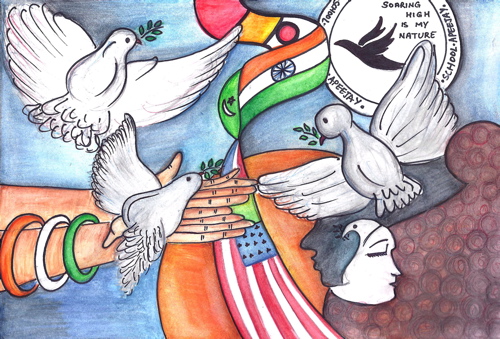
Peace Quilt designed by 9th grader Vidhi Jain, Apeejay School, Pitampura, India; courtesy peacequilt.wordpress.com
Editor’s Preface: We have posted a series of statements by Gandhi that very much address situations and conflicts we currently face, as with his statements on Truth. The “nuclear menace” is much in the news again. These extracts are then being posted in August, the anniversary month of the bombings of Hiroshima and Nagasaki. Please consult the notes at the end for notes, and sources. JG
Has not the atom bomb proved the futility of all violence? (1)
There have been cataclysmic changes in the world. Do I still adhere to my faith in truth and non-violence? Has not the atom bomb exploded that faith? Not only has it not done so, but it has clearly demonstrated to me that truth and non-violence constitute the mightiest force in the world. Before it the atom bomb is of no effect. The two opposing forces are wholly different in kind, the one moral and spiritual, the other physical and material. The one is infinitely superior to the other which by its very nature has an end.
Read the rest of this article »
by Henry S. L. Polak
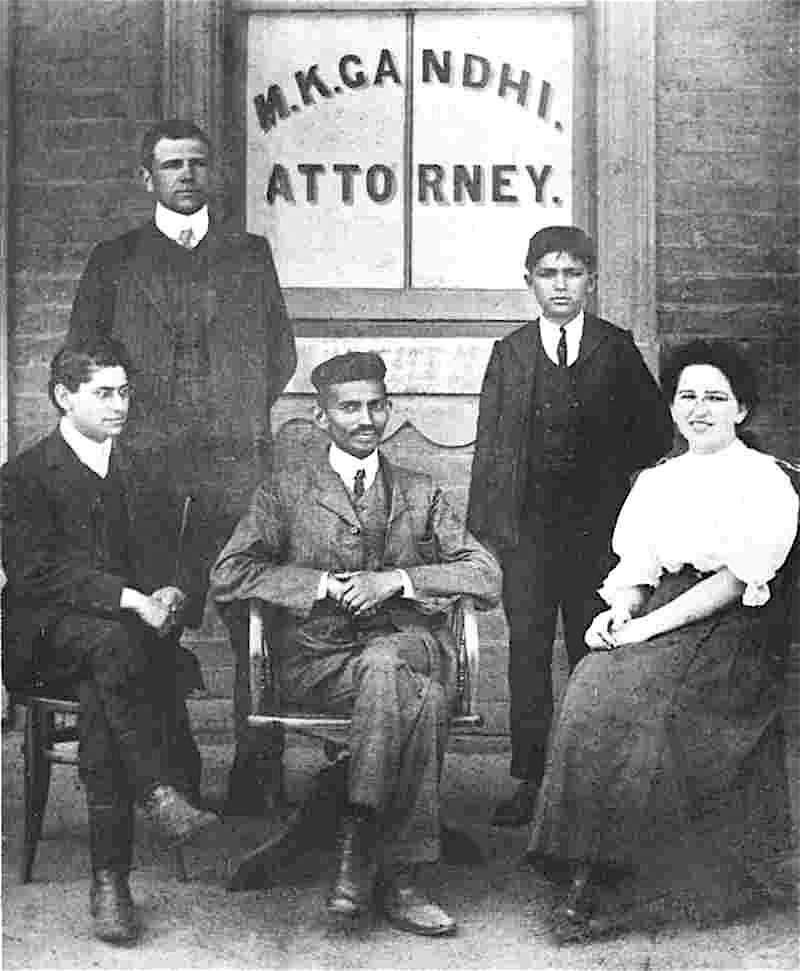
Gandhi in front of his Johannesburg law office, 1905, with Henry Polak (left), Sonia Schlesin; others unidentified.
Editor’s Preface: This 1949 article by Polak is often cited as a primary source of information about Gandhi’s South African years and the events surrounding Gandhi’s coining of the term, “Satyagraha”. Henry S. L. Polak edited Indian Opinion, which he co-founded with Gandhi and is credited with giving Gandhi a copy of Ruskin’s Unto This Last, which Gandhi cites as one of his most important influences. For further biographical and textual information please see the notes at the end. JG
Mahatma Gandhi’s technique of Satyagraha, or, as it was first known, Passive Resistance, had its origins in South Africa. It was in 1906, twelve years after Gandhi’s arrival there, that the flame of Satyagraha began to glow. Until then, the Indian grievances had been dealt with in the usual orthodox ways of petitions, memoranda, addresses, questions in Parliament, public speeches, and so on. But the time had now arrived when, all these having proved fruitless, new and radical methods had to be devised, their consequences considered, and redress thereby determined upon, at whatever cost to those suffering under social, economic, and political disabilities that must no longer be tolerated.
Read the rest of this article »
by Rajendra Prasad
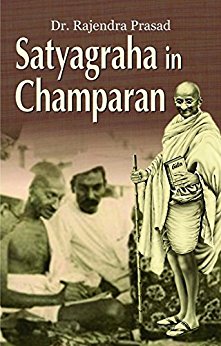
Dustwrapper art courtesy Ocean Books; oceanbooks.in
Editor’s Preface: The historical accounts of the Indian nonviolent independence movement generally focus on Mahatma Gandhi’s campaigns, whereas the Satyagraha Movement was widespread across India, with more than one leader. Rajendra Prasad (1884-1963) was one such. The account that follows draws a vivid picture of the courage and sacrifice of the campaign that Prasad led in 1930 in his home state of Bihar. His leadership qualities and commitment to nonviolence were well recognized; when India gained independence from Great Britain in 1947 he was chosen its first president. Please see our explanatory endnotes, note on the text, and editor’s note at the end of the article. JG
An outstanding example of the faith and firmness with which people acted on Mahatma Gandhi’s words was provided, in 1930, at Bihpur in Bhagalpur. (1) Bihpur is on the banks of the Ganges and is exposed to floods. The river always changes its course, as happens in all places near the Ganges. As a consequence, the boundaries marking off one man’s field from another’s are washed away, and when the floods subside, very often conflicts arise among rival claimants of land. […]
When I was touring that region in 1929, I found evidence of great enthusiasm among the people. I was convinced that when Satyagraha was started, its inhabitants would enthusiastically participate in it. I carried this impression because of an incident which occurred there. In the course of my tour, I had fixed up a meeting to be held at a particular place about two o’clock in the afternoon. I had been to another village at some distance from the place where the meeting was to be held, and had hoped to return in time for it. While I was on my way back, heavy rain came down suddenly, a strong wind began to blow, and I was delayed for two or three hours. When I arrived, soaked to the skin, I found a very big crowd which, I was told, had been awaiting my arrival in the rain for some hours. The rain itself was still falling. I stood up in the crowd in the rain and talked to them. It was this incident which impressed itself on my mind that the people of that region had courage as well as determination.
Read the rest of this article »
by Mohandas K. Gandhi
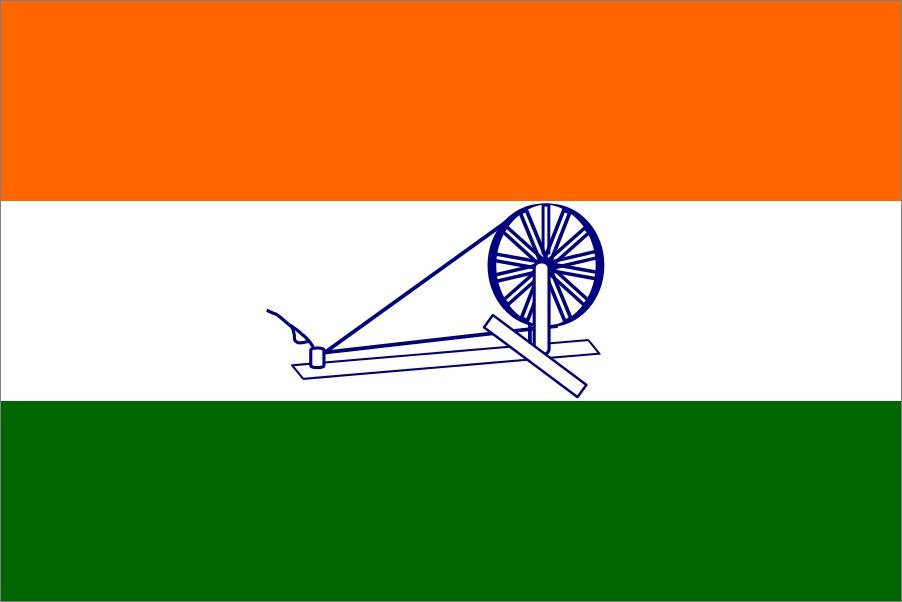
1929 proposed flag of India, with Gandhian spinning wheel; courtesy en.wikipedia.org
Editor’s Preface: The Indian National Congress formally approved “The Declaration of the Independence of India” on December 19, 1929, and it is important to understand it in its historical context. (1) Purna swaraj can be translated as “complete, sovereign independence,” that is, Indian independence from Great Britain and the ending of colonial rule. Various models had been proposed for Indian sovereignty prior to 1930, including several versions of power sharing. However, a sequence of events by the British government, violating or curtailing Indian civil rights, resounded as a betrayal to Gandhi. The “Declaration” marks a turning point in Gandhi’s thinking about Britain, and the nature of India’s future relationship with British rule. (2) There has been some disagreement as to its authorship, but Gandhi can be said to have solved the matter in February 1937 when he wrote,“ I was its author. I wanted the people not merely to repeat the mantra of independence but to educate the people as to its why and wherefore.” (3) Purna Swaraj was to be read throughout the country on January 26, 1930, and that date is still celebrated as India Independence Day. Please also see our explanatory notes at the end. JG
Purna Swaraj
We believe that it is the inalienable right of the Indian people, as of any other people, to have freedom and to enjoy the fruits of their toil and have the necessities of life, so that they may have full opportunities of growth. We believe also that if any government deprives a people of these rights and oppresses them the people have a further right to alter it or to abolish it. The British Government in India has not only deprived the Indian people of their freedom but has based itself on the exploitation of the masses, and has ruined India economically, politically, culturally, and spiritually. We believe, therefore, that India must sever the British connection and attain Purna Swaraj, or complete independence.
Read the rest of this article »
by Mark Engler and Paul Engler
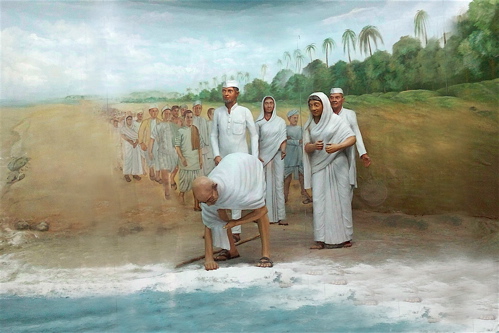
“Gandhi Takes Salt”; Sabarmati Ashram mural photo courtesy blogeswara.wordpress.com
At the end of 1930, India was experiencing disruption on a scale not seen in nearly three quarters of a century — and it was witnessing a level of social movement participation that organizers who challenge undemocratic regimes usually only dream of achieving.
A campaign of mass non-cooperation against imperial rule had spread throughout the country, initiated earlier that year when Mohandas Gandhi and approximately 80 followers from his religious community set out on a Salt March protesting the British monopoly on the mineral. Before the campaign was through, more than 60,000 people would be arrested, with as many as 29,000 proudly filling the jails at one time. Among their ranks were many of the most prominent figures from the Indian National Congress, including politicians that had once been reluctant to support nonviolent direct action.
Read the rest of this article »
by Arvind Sharma
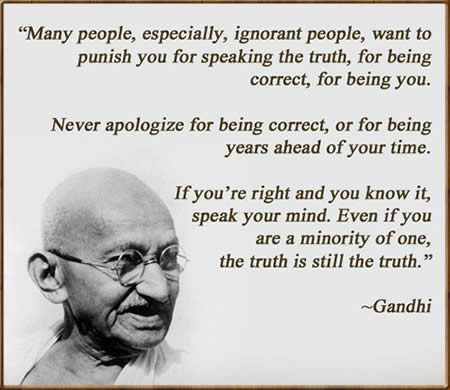
Gandhi poster courtesy rishikajain.com
Truth and nonviolence are generally considered to be the two key ingredients of Gandhian thought. It is possible to pursue one without the other, possible, for example, to pursue truth without being nonviolent. Nations go to war believing truth is on their side, or that they are on the side of truth. The more sensitive among those who believe truth is on their side insist not that there should be no war but that it should be a just war. The most sensitive, however, and pacifists are among these, avoid violence altogether. But it could be argued that in doing so they have gone too far and have abandoned truth, and even justice. Although he was opposed to war, Gandhi argued that the two parties engaging in it may not stand on the same plane: the cause of one side could be more just than the other, so that even a nonviolent person might wish to extend his or her moral support to one side rather than to the other.
Just as it is possible to pursue truth without being nonviolent, it is also possible to pursue nonviolence without pursuing truth. In fact, it could be proposed that a disjunction between the two runs the risk of cowardice being mistaken for, or masquerading as, nonviolence. The point becomes clear if we take the world “truth” to denote the “right” thing to do in a morally charged situation. Gandhi was fond of quoting the following statement from Confucius: “To know what is right and not to do it is cowardice.”
Read the rest of this article »
by Mohandas K. Gandhi

School of Andries Cornelis Lens, “Truth Protecting Us with Her Shield”, c. 1750; courtesy wikigallery.org
Editor’s Preface: “Truth”, “lies”, “alternate facts”, “post-truth politics”, etc., are terms very much in the air these days. Gandhi had much to say about Truth; the selection below is only a small sample focused on the root concepts behind his use of the term, and by application the root of his theory of nonviolence. This is the first of a series of articles we will be posting over the next few months on truth and truth in politics. Other statements on Satyagraha and Truth can be found on our Quotes and Sources page, via the link at the top of the page. JG
(I) The word Satya (Truth) is derived from Sat, which means ‘being’. Nothing is or exists in reality except Truth. That is why Sat or Truth is perhaps the most important name of God. In fact it is more correct to say that Truth is God, than to say that God is Truth. But as we cannot do without a ruler or a general, such names of God as ‘King of Kings’ or ‘The Almighty’ are and will remain generally current. On deeper thinking, however, it will be realised, that Truth (Sat or Satya) is the only correct and fully significant name for God.
And where there is Truth, there also is true knowledge. Where there is no Truth, there can be no true knowledge. That is why the word Chit or knowledge is associated with the name of God. And where there is true knowledge, there is always bliss (Ananda). There sorrow has no place. And even as Truth is eternal, so is the bliss derived from it. Hence we know God as Sat-Chit-Ananda, one who combines in Himself Truth, knowledge and bliss. (1)
Read the rest of this article »
by Richard B. Gregg
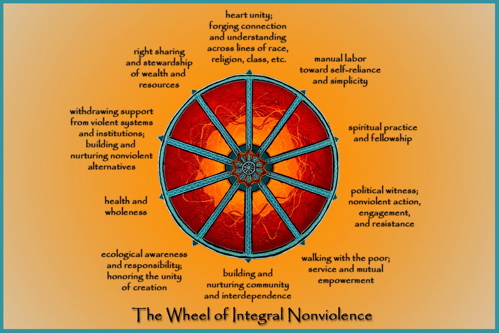
The Wheel of Integral Non-violence is courtesy of chico-peace.org
Editor’s Preface: This 1941 article, with its Foreword by Gandhi, continues our series of important historical documents on the theory and history of Gandhian nonviolence. Gregg here argues for the value of manual labor, as advocated by John Ruskin, and as practiced by Gandhi in his ashrams, where Gregg had lived. Gandhi considered spinning and weaving essential to the routine of a nonviolent community, yet this article is one of the very few to try to explicate this. Please also see the Editor’s Note at the end for more information about Gregg, and please also consult his other article, which we have posted here. JG
Foreword (by M. K. Gandhi): ‘A Discipline for Non-violence’ is a pamphlet written by Mr. Richard B. Gregg for the guidance of those Westerners who endeavour to follow the law of Satyagraha. I use the word advisedly instead of ‘pacifism’. For what passes under the name of pacifism is not the same as Satyagraha. Mr. Gregg is a most diligent and methodical worker. He had first-hand knowledge of Satyagraha, having lived in India and then too for nearly a year in the Sabarmati Ashram. His pamphlet is seasonable and cannot fail to help the Satyagrahis of India. For though the pamphlet is written in a manner attractive for the West, the substance is the same for both the Western and the Eastern Satyagrahi. A cheap edition of the pamphlet is therefore being printed locally for the benefit of Indian readers in the hope that many will make use of it and profit by it. A special responsibility rests upon the shoulders of Indian Satyagrahis, for Mr Gregg has based the pamphlet on his observation of the working of Satyagraha in India. However admirable this guide of Mr. Gregg’s may appear as a well-arranged code, it must fail in its purpose if the Indian experiment fails. (Sevagram, 24-8-1941)
A Discipline for Non-violence
For ages military discipline has won and held men’s faith. However crude, indiscriminate, and brief may be the results of organized violence, the world still has immense respect for its show of firmness and order. Much as we dislike war, when we begin to ask how we can attain justice and peace, we come face to face with this power of the military method. What is the secret of this power? Does it lie merely in men’s fear of violence?
Read the rest of this article »
by Thomas Weber
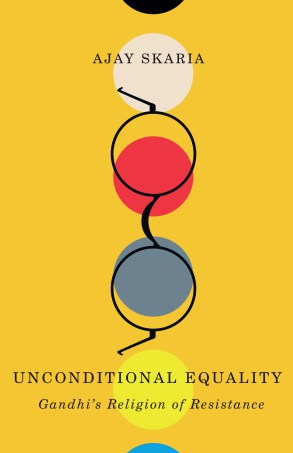
Cover art courtesy University of Minnesota Press; upress.umn.edu
As a university student with an interest in existential philosophy, I remember struggling with Jean-Paul Sartre’s Being and Nothingness. At times there were even consecutive pages that made sense to me, but more often there were only single paragraphs separated by many pages of dense language and philosophical concepts that were beyond my comprehension. I was very thankful when I came across Sartre’s essay “Humanism as an Existentialism” and suddenly what he was trying to say came into focus and made sense. How much I lost by not comprehending the probably profounder text, I will never know. Readers of some of the latest scholarly offerings in the attempts to understand the life and thought of Mohandas Karamchand Gandhi may find themselves in a similar position while waiting for the simpler more readily graspable versions to materialise. But then, weighty philosophical concepts are weighty philosophical concepts and possibly they are not meant for a wider audience that has little desire or ability to engage in deep theoretical philosophical discourse.
Once, writings about Gandhi were biographies, often hagiographical (for example by Louis Fischer); personal reminiscences, usually hagiographical (for example by his most well known British disciple Mirabehn); and selections of the Mahatma’s thoughts grouped in various categories, generally selected by those who were followers (R.K.Prabhu and U.R.Rao, Anand Hingorani, N.K.Bose and Krishna Kripalani come to mind). Of course there were serious attempts at analysing Gandhi’s campaigns through primary archival sources (for example by Judith Brown) and more probing attempts to make sense of his world view and what led him to have it (here one could list Gopinath Dhawan, T.K.N.Unnithan and Erik Erikson). During 1969, the Gandhi birth centenary year, dozens of books appeared. More recently, although there was the occasional controversy (particularly over the writings of James Lelyveld and Jad Adams), it has become almost fashionable to ensure that Gandhi scholarship can in no way be seen as hagiographical, with writers doing their utmost to undermine the “myth of the Mahatma”, by pointing out Gandhi’s inconsistencies, his youthful elitist and even racist attitudes (for example by Desai and Vahed), his older-age, controversial experiments in sexuality, and even labelling him as a traitor in the project of the creation of modern India (too many to mention). Even more recently, however, there has been another trend where scholars with a strong theoretical bent and deep philosophical knowledge have taken the Mahatma seriously and decided to turn their attention to his life and an analysis of his praxis (and here we could mention the writings of Vinay Lal, Faisal Devji, Isabel Hofmeyr and Tridip Suhrud among a growing cohort). Ajay Skaria’s Unconditional Equality: Gandhi’s Religion of Resistance (Minneapolis: University of Minnesota Press, 2016) is a prime example of this development.
Read the rest of this article »














